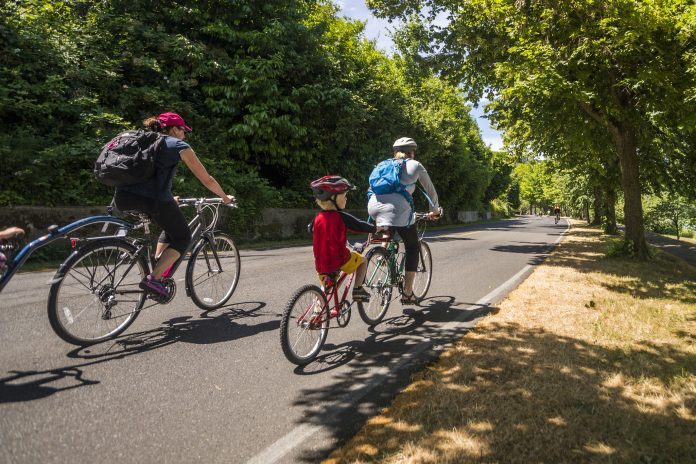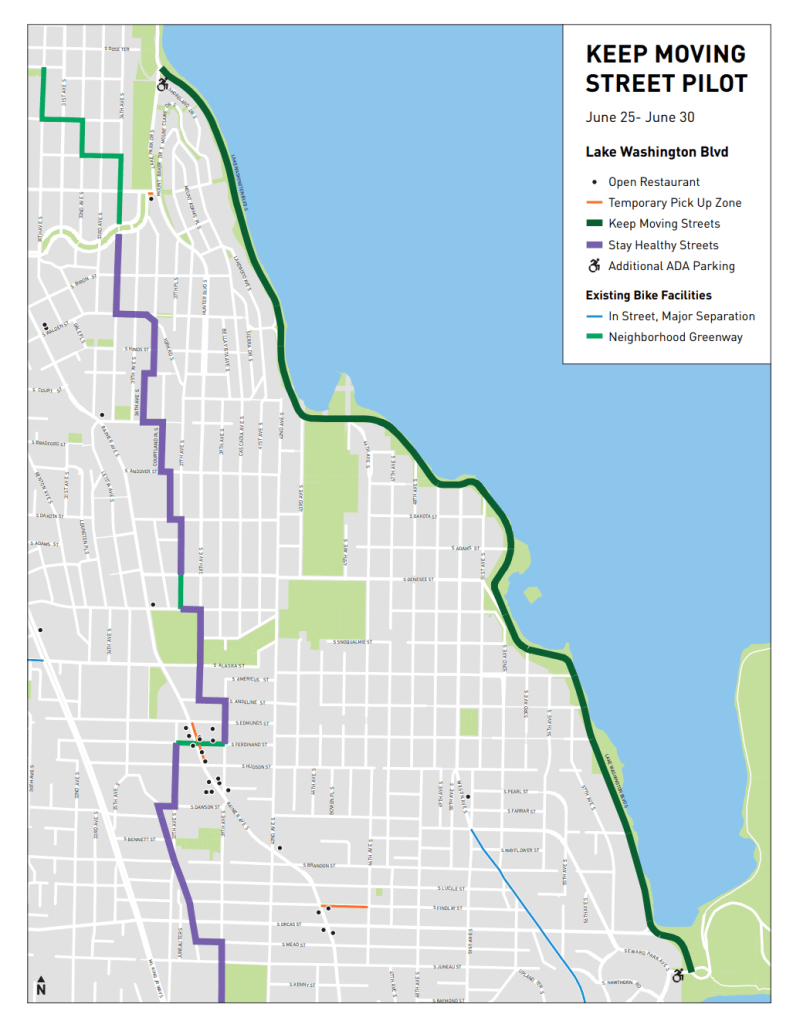
The Seattle Department of Transportation (SDOT) confirmed Tuesday that a three-mile stretch of Lake Washington Boulevard will be an open street for the remainder of summer. The program will begin on Friday, July 24th and continue through September 8th (Labor Day).
Seattle Neighborhood Greenway and its local chapter Rainier Valley Greenways-Safe Streets were instrumental in advocating for the open street to help people safely get around Southeast Seattle. The South End has long been identified as the most pressing gap in the bike network.
“We’re excited that SDOT will be opening up Lake Washington Blvd for people to walk, bike, run, and roll this summer,” Seattle Greenways Executive Director Gordon Padelford said. “Giving people more space to safely get some exercise is critical right now. We hope the city will engage the community to address concerns as they arise, and help imagine what a longer term solution could look like.”
The open street will be implemented from Mount Baker Beach to Seward Park, as a five-day pilot tested out in late June. SDOT reported on the results on the findings in its blog post announcing the extension. The agency said extending the open street through September was also a possibility and to expect an announcement “around Labor Day.” A Seattle Times poll showed many were clamoring for an open street on Lake Washington Boulevard, which has long seen Sunday Parkways closures to cars.
“Rainier Valley Greenways is pleased that Lake Washington Blvd will be closed to cars, and safe for biking and walking for the weeks ahead. This is the right decision for public health during the pandemic,” Rainier Valley Greenways chair Andrew Kidde said. “We also recognize that some folks are not pleased with this closure, and we encourage the City to find creative solutions to these concerns when possible. Finally, after the pandemic is over, we urge the City to explore permanent changes to Lake Washington Boulevard, such as making it a one-way street, that maintain this as a safe walking and biking route.”

SDOT is branding the Lake Washington Boulevard open street as a “Keep Moving Street” rather than a “Stay Healthy Street” like the first 20 miles of open streets it implemented. The distinction here is murky, so I think it’s best we treat the names as interchangeable or just use the more common catchall “open streets.” The alternative is to delve into subtle distinctions like Stay Healthy Streets being neighborhood-focused and Keep Moving Streets being park-focused–or whatever the difference is supposed to be. Confusingly, Stay Healthy Streets promotional materials also use the Keep It Moving slogan.
Lake Washington Boulevard and the 20 miles of “Stay Healthy Streets” the City has promised to make permanent could be the tip of the iceberg. Seattle Greenways has a citywide map recommending 130 miles of open streets that The Urbanist has also endorsed. The results speak for themselves: “Around 67% of people who provided input enjoyed the pilot.”
The data from the five-day pilot lent support for making it a permanent program, as SDOT’s Sara Davis detailed in the blog post. Cycling was up during the pilot except during an unseasonably cool Saturday–but no so much so to risk overcrowding, the agency argued. SDOT reported that motorists were adhering to the restrictions.
“A vast majority of drivers respected the Street Closed signs. Vehicle volumes typically range from 53 to 440 per hour and dropped to zero to 10 per hour,” Davis wrote. “The busiest times were late afternoon into the early evening. Turning volumes reduced but much more modestly, suggesting local access was maintained for residents and service trips.”
Seattle Parks and Recreation has closed parking lots along Lake Washington Boulevard to reduce crowding, which is typically most pronounced during Seafair activities. With Covid transmission remaining stubbornly high, precautions like these will likely stay in place.
SDOT attempted to measure pedestrian use via a counter near Genesee Park, but since it only measured people crossing the street rather than walking along it, the data seems of limited usefulness. For what it’s worth, the pedestrian counter measured a bit of decrease during the pilot.
Now that the open streets program is in place for the rest of the summer, there’ll be more of chance to get more of a buzz and for word to spread. In fact, people may find they’d prefer to make it a year-round feature–perhaps by using the one-way design that Rainier Valley Greenways has proposed. But for now, take a stroll, roll, or ride along Lake Washington to enjoy it while it lasts.
Doug Trumm is publisher of The Urbanist. An Urbanist writer since 2015, he dreams of pedestrian streets, bus lanes, and a mass-timber building spree to end our housing crisis. He graduated from the Evans School of Public Policy and Governance at the University of Washington in 2019. He lives in Seattle's Fremont neighborhood and loves to explore the city by foot and by bike.

